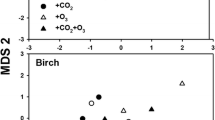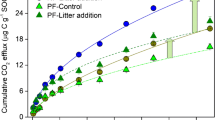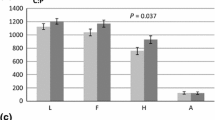Abstract
The future capacity of forest ecosystems to sequester atmospheric carbon is likely to be influenced by CO2-mediated shifts in nutrient cycling through changes in litter chemistry, and by interactions with pollutants like O3. We evaluated the independent and interactive effects of elevated CO2 (560 μl l−1) and O3 (55 nl l l−1) on leaf litter decomposition in trembling aspen (Populus tremuloides) and paper birch (Betula papyrifera) at the Aspen free air CO2 enrichment (FACE) site (Wisconsin, USA). Fumigation treatments consisted of replicated ambient, +CO2, +O3, and +CO2 + O3 FACE rings. We followed mass loss and litter chemistry over 23 months, using reciprocally transplanted litterbags to separate substrate quality from environment effects. Aspen decayed more slowly than birch across all treatment conditions, and changes in decomposition dynamics of both species were driven by shifts in substrate quality rather than by fumigation environment. Aspen litter produced under elevated CO2 decayed more slowly than litter produced under ambient CO2, and this effect was exacerbated by elevated O3. Similarly, birch litter produced under elevated CO2 also decayed more slowly than litter produced under ambient CO2. In contrast to results for aspen, however, elevated O3 accelerated birch decay under ambient CO2, but decelerated decay under enriched CO2. Changes in decomposition rates (k-values) were due to CO2- and O3-mediated shifts in litter quality, particularly levels of carbohydrates, nitrogen, and tannins. These results suggest that in early-successional forests of the future, elevated concentrations of CO2 will likely reduce leaf litter decomposition, although the magnitude of effect will vary among species and in response to interactions with tropospheric O3.





Similar content being viewed by others
References
Bartos DL, Debyle NV (1981) Quantity, decomposition, and nutrient dynamics of aspen litterfall in Utah. Forest Sci 27:381–90
Berg B (2000) Initial rates and limit values for decomposition of Scots pine and Norway spruce needle litter: a synthesis for N-fertilized forest stands. Can J Forest Res 30:122–35
Berg B, Ekbohm G (1991) Litter mass-loss rates and decomposition patterns in some needle and leaf litter types. Long-term decomposition in a Scots pine forest. VII. Can J Bot 69:1449–56
Berg B, Ekbohm G, Johansson M-B, McClaugherty C, Rutigliano F, Virzo De Santo A (1996) Maximum decomposition limits of forest litter types: a synthesis. Can J Bot 74:659–72
Blair JM (1988) Nitrogen, sulfur and phosphorus dynamics in decomposing deciduous leaf litter in the southern Appalachians. Soil Biol Biochem 20:693–701
Bockheim JG, Jepsen EA, Heisey DM (1991) Nutrient dynamics in decomposing leaf litter of four tree species on a sandy soil in northwestern Wisconsin. Can J Forest Res 21:803–12
Burns RM, Honkala BH, Eds. 1990. Silvics of North America. 2. Hardwoods, Handbook 654. United States Department of Agriculture Forest Service
Chen HYH, Popadiouk RV (2002) Dynamics of North American boreal mixed woods. Environ Rev 10:137–66
Cornelissen JHC, Perez-Harguindeguy N, Gwynn-Jones D, Diaz S, Callaghan TV, Aerts R (2000) Autumn leaf colours as indicators of decomposition rate in sycamore (Acer pseudoplatanus L.). Plant Soil 225:33–8
Cotrufo MF, De Angelis P, Polle A (2005) Leaf litter production and decomposition in a poplar short-rotation coppice exposed to free air CO2 enrichment (POPFACE). Global Change Biol 11:971–82
Dickson RE, Lewin KF, Isebrands JG, Coleman MD, Heilman WE, Riemenschneider DE, Sôber J, Host GE, Zak DR, Hendrey GR, Pregitzer KS, Karnosky DF. 2000. Forest atmosphere carbon transfer storage-II (FACTS II). The aspen free-air CO2 and O3 enrichment (FACE) project: an overview. USDA Forest Service, North Central Research Station. General Tech. Report NC-214. 68 pp
Dukes JS, Hungate BA (2002) Elevated CO2 and litter decomposition in California annual grasslands: which mechanisms matter? Ecosystems 5:171–83
Filion M, Dutilleul P, Potvin C (2000) Optimum experimental design for free-air carbon dioxide enrichment (FACE) studies. Global Change Biol 6:843–54
Findlay S, Carreiro M, Krischik V, Jones CG (1996) Effects of damage to living plants on leaf litter quality. Ecol Appl 6:269–75
Findlay S, Jones CG (1990) Exposure of cottonwood plants to ozone alters subsequent leaf decomposition. Oecologia 82:248–50
Finzi AC, Allen AS, DeLucia EH, Ellsworth DS, Schlesinger WH (2001) Forest litter production, chemistry and decomposition, following two-years of free-air CO2 enrichment. Ecology 82:470–84
Finzi AC, Schlesinger WH (2002) Species control variation in litter decomposition in a pine forest exposed to elevated CO2. Global Change Biol 8:1217–29
Giardina CP, Ryan MG, Hubbard RM, Binkley D (2001) Tree species and soil textural controls on carbon and nitrogen mineralization rates. Soil Sci Soc Am J 65:1272–9
Hogg EH, Brandt JP, Kochtubajda B (2002) Growth and dieback of aspen forests in northwestern Alberta, Canada, in relation to climate and insects. Can J Forest Res 32:823–32
Holmes WE, Zak DR, Pregitzer KS, King JS (2006) Elevated CO2 and O3 alter soil nitrogen transformations beneath trembling aspen, paper birch, and sugar maple. Ecosystems 9:1354–63
Howard PJA, Howard DM (1974) Microbial decomposition of tree and shrub leaf litter. Oikos 25:341–52
Karnosky DF, Gielen B, Ceulemans R, Schlesinger WH, Norby RJ, Oksanen R, Matyssek R, Hendrey GR (2001) FACE systems for studying the impacts of greenhouse gases on forest ecosystems. In: Karnosky DF, Scarascia-Mugnozza G, Ceulemans R, Innes J (eds) The impact of carbon dioxide and other greenhouse gases on forest ecosystems. CAB International, Wallingford (UK), pp. 297–324
Karnosky DF, Mankovska B, Percy K, Dickson RE, Podila GK, Sôber J, Noormets A, Hendrey G, Coleman MD, Kubiske M, Pregitzer KS, Isebrands JG (1999) Effects of tropospheric O3 on trembling aspen and interaction with CO2: results from an O3-gradient and a FACE experiment. Water Air Soil Pollut 116:311–22
Karnosky DF, Percy KE, Xiang B, Callan B, Noormets A, Mankovska B, Hopkin A, Sôber J, Jones W, Dickson RE, Isebrands JG (2002) Interacting elevated CO2 and tropospheric O3 and predisposes aspen (Populus tremuloides Michx.) to infection by rust (Melampsora medusae f. sp. tremuloidae). Global Change Biol 8:329–38
Karnosky DF, Pregitzer KS, Zak DR, Kubiske ME, Hendry GR, Weinstein D, Nosal M, Percy KE (2005) Scaling ozone responses of forest trees to the ecosystem level in a changing climate. Plant Cell Environ 28:965–81
Karnosky DF, Zak DR, Pregitzer KS, Awmack CS, Bockheim JG, Dickson RE, Hendrey GR, Host GE, King JS, Kopper BJ, Kruger EL, Kubiske ME, Lindroth RL, Mattson WJ, McDonald EP, Noormets A, Oksanen E, Parsons WFJ, Percy KE, Podila GK, Riemenschneider DE, Sharma P, Sôber A, Sôber J, Jones WS, Anttonen S, Thakur RC, Vapaavuori E, Mankovska B, Heilman W, Isebrands JG (2003) Tropospheric O3 moderates functional responses of temperate hardwood forests to elevated CO2: a synthesis of molecular to ecosystem results from the Aspen FACE project. Funct Ecol 17:289–304
King JS, Pregitzer KS, Zak DR, Kubiske ME, Ashby JA, Holmes WE (2001) Chemistry and decomposition of litter from Populus tremuloides Michaux grown at elevated atmospheric CO2 and varying N availability. Global Change Biol 7:65–74
Koricheva J, Larsson S, Hankioja E, Keinanen M (1998) Regulation of woody plant secondary metabolism by resource availability: hypothesis testing by means of meta-analysis. Oikos 83:212–26
Kubiske ME, Quinn VS, Marquardt PE, Karnosky DF (2007) Effects of elevated atmospheric CO2 and/or O3 on intra- and interspecific competitive ability of aspen. Plant Biol 9:342–55
Latter PM, Howson G, Howard DM, Scott WA (1998) Long-term study of litter decomposition on a Pennine peat bog: which regression? Oecologia 113:94–103
Lindroth RL, Kinney KK, Platz CL (1993) Responses of deciduous trees to elevated atmospheric CO2: productivity, phytochemistry and insect performance. Ecology 74:763–77
Lindroth RL, Osier TL, Barnhill HRH, Wood SA (2002) Effects of genotype and nutrient availability on phytochemistry of trembling aspen (Populus tremuloides Michx.) during leaf senescence. Biochem Syst Ecol 30:297–307
Littell RC, Milliken GA, Stroup WW, Wolfinger RD (1996) SAS system for mixed models. SAS Institute, Inc., Cary, NC, USA
Liu L, King JS, Giardina CP (2005) Effects of elevated concentrations of atmospheric CO2 and tropospheric O3 on leaf litter production and chemistry in trembling aspen and paper birch communities. Tree Physiol 25:1511–22
Loya WM, Pregitzer KS, Karberg NJ, King JS, Giardina CP (2003) Reduction of soil carbon formation by tropospheric ozone under increased carbon dioxide levels. Nature 425:705–7
Mattson WJ, Julkoen-Tiitto R, Herms DA (2005) CO2 enrichment and carbon partitioning to phenolics: do plant responses accord better with the protein competition or the growth-differentiation balance models? Oikos 111:337–47
Norby RJ, Long TM, Hartz-Rubin JS, O’Neill EG (2000) Nitrogen resorption in senescing tree leaves in a warmer, CO2-enriched atmosphere. Plant Soil 224:15–29
Olson JS (1963) Energy storage and the balance of producers and decomposition in ecological systems. Ecology 44:322–31
Parsons WFJ, Lindroth RL, Bockheim JG (2004) Decomposition of Betula papyrifera leaf litter under the independent and interactive effects of elevated CO2 and O3. Global Change Biol 10:1666–77
Peltonen PA, Vapaavuori E, Julkunen-Tiito R (2005) Accumulation of phenolic compounds in birch leaves is changed by elevated carbon dioxide and ozone. Global Change Biol 11:1305–24
Porter LJ, Hrstich LN, Chan BG (1986) The conversion of procyanidins and prodelphinidins to cyanidin and delphinidin. Phytochemistry 25:223–30
Prescott CE (2005) Do rates of litter decomposition tell us anything we really need to know? Forest Ecol Manag 220:66–74
Prescott CE, Vesterdal L, Preston CM, Simard SW (2004) Influence of initial chemistry on decomposition of foliar litter in contrasting forest types in British Columbia. Can J Forest Res 34:1714–29
Randlett DL, Zak DR, Pregitzer KS, Curtis PS (1996) Elevated atmospheric CO2 and leaf litter chemistry: influences on microbial respiration and net N mineralization. Soil Sci Soc Am J 60:1571–7
Taylor BR, Parkinson D (1988) Annual differences in quality of leaf litter of aspen (Populus tremuloides) affecting rates of decomposition. Can J Bot 66:1940–7
Taylor BR, Parkinson D, Parsons WFJ (1989) A microcosm test of nitrogen and lignin content as predictors of litter decay rates. Ecology 70:97–104
Trofymow JA, Moore TR, Titus B, Prescott C, Morrison I, Siltanen M, Smith S, Fyles J, Wein R, Camiré C, Duchesne L, Kozak L, Kranabetter M, Visser S (2002) Rates of litter decomposition over 6 years in Canadian forests: influence of litter quality and climate. Can J Forest Res 32:789–804
Valachovic VS, Caldwell BA, Cromack Jr K, Griffiths RP (2004) Leaf litter chemistry controls on decomposition of Pacific Northwest trees and woody shrubs. Can J Forest Res 34:2131–47
Van Cleve K (1971) Energy- and weight-loss functions for decomposing foliage in birch and aspen forests in interior Alaska. Ecology 52:720–3
Acknowledgments
Research funds were provided by a US Department of Energy grant (DE-FG02-98ER62680) to RLL and JGB, and a US Department of Agriculture grant (NRI 95-37302-1810) to RLL. Aspen FACE is supported principally by the Office of Science (BER), US Department of Energy (DE-FG02-95ER62125), the US Forest Service Northern Global Change Program and North Central Research Station, Michigan Technological University, and Natural Resources Canada—Canadian Forest Service. We thank the Aspen-FACE steering committee and site operators, Jaak Sôber and Scott Jacobsen, for providing access to the facility. For their help in collecting, processing, and analyzing litter, we thank Adam Gusse, and especially Heidi Barnhill, who rode herd on our army of undergraduate assistants (Daniel Beisner, Michael Drews, Beth Kazlauskas, Kari Klasen, Kelly Krein, Nasuh Malas, Melissa Naub, Laura Riel, Joshua Rudinsky, Lindsay Wieczorek, Sarah Wood, and Kathryn Zachman). We thank Matthias Jaime for creating the figures. Edward Rastetter and two anonymous reviewers provided helpful reviews of the manuscript.
Author information
Authors and Affiliations
Corresponding author
Rights and permissions
About this article
Cite this article
Parsons, W.F.J., Bockheim, J.G. & Lindroth, R.L. Independent, Interactive, and Species-Specific Responses of Leaf Litter Decomposition to Elevated CO2 and O3 in a Northern Hardwood Forest. Ecosystems 11, 505–519 (2008). https://doi.org/10.1007/s10021-008-9148-x
Received:
Revised:
Accepted:
Published:
Issue Date:
DOI: https://doi.org/10.1007/s10021-008-9148-x




